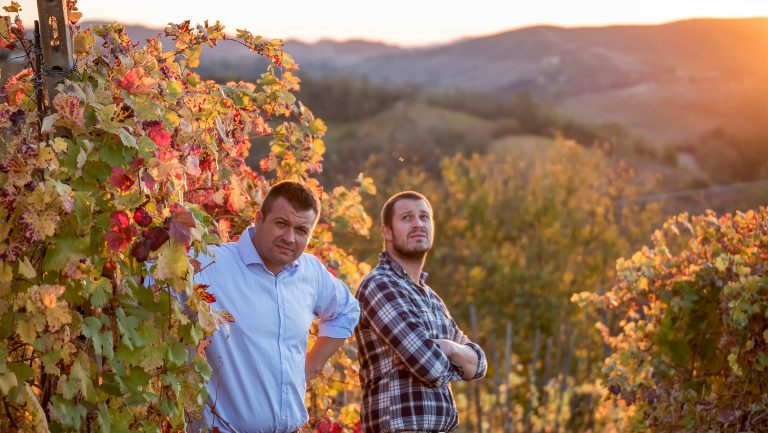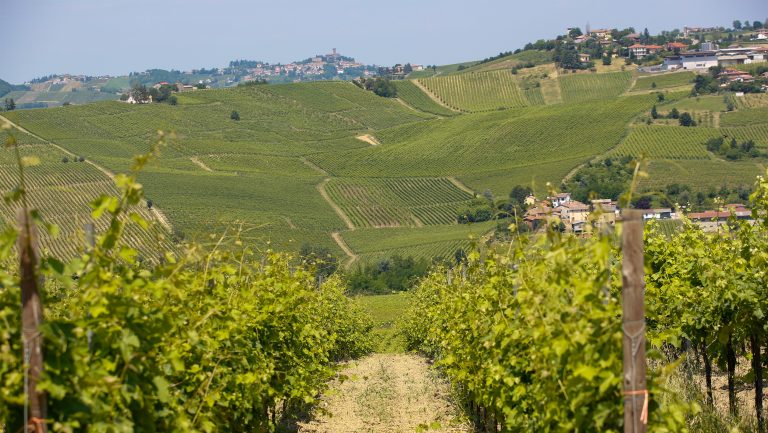When most people think of Italian Riesling, the wines from the northeastern Trentino-Alto Adige spring to mind. Yet, producers in the gently undulating valleys of Lombardy’s Oltrepò Pavese are bottling some of the country’s most vibrant examples of the grape.
Sprawled across hills that stretch as high as 600 meters, Oltrepò Pavese (“Pavia beyond the Po”) lies 65 kilometers south of Milan. Sixty-five percent of the region’s 13,000 hectares under vine belong to Pinot Noir, the grape comprising the hallmark Oltrepò Pavese DOCG Metodo Classico. In comparison, Riesling represents 10 percent of the region’s vines.
In Italy, “Riesling” applies to either Riesling Italico, also known as Welschriesling, or Riesling Renano, the Rhine variety. These grapes comprise 1,300 hectares in Oltrepò Pavese: 1,000 of the Italico variety, while Renano, which arrived with the Habsburgs in the 19th century, spans 300 and counting.

Don’t miss the latest drinks industry news and insights. Sign up for our award-winning newsletters and get insider intel, resources, and trends delivered to your inbox every week.
The dryer Oltrepò-style Riesling Renano packs more alcohol than its northeastern counterparts. Giacomo Baruffaldi, who co-owns Castello di Stefanago with his brother Antonio, explains that the microclimate and well-ventilated hills in Oltrepò Pavese contribute to the wine’s individuality. Still, he believes that “it’s the terroir that makes it special: clay mixed with sand and lime under a layer of very calcareous soil.”
The climate, characterized by a 6-degrees-celsius diurnal range and the juxtaposition of a warm Mediterranean breeze from Liguria with a cool Alpine wind from Mont Blanc, also fosters conditions for the variety to thrive, according to Gabriele Marchesi, the fourth-generation owner of Marchesi di Montalto winery.
In recent years, a new generation of Oltrepò Pavese winemakers has sharpened their focus on the Renano variety, emphasizing the grape’s local personality—and slowly shifting public perception of Italian Riesling.
The Valley of Riesling
When Marchesi took over Marchesi di Montalto, his family’s winery, in 2001, it had a single hectare of Riesling Renano. His predecessors had vinified the grape as a sparkling wine, producing 3,000 bottles a year, but Marchesi believed they had yet to maximize the grape’s potential. That same year, he embarked on the first of several trips to the Mosel—the cradle of Riesling Renano with 5,446 hectares under vine—to better understand the variety. Six years later, La Valle del Riesling Oltrepò was born.

The project is a collaboration with Mosel winemakers to promote Riesling Renano within Oltrepò Pavese. Together, they identified optimal vineyards on Marchesi’s land and nearby and planted 50 hectares of Mosel’s Heinz 65 clone in six communes: Calvignano, Montalto Pavese, Oliva Gessi, Casteggio, Mornico Losana, and Rocca de’ Giorgi.
Today, Marchesi harvests 12 hectares of Riesling Renano, the core of four wines he crafts according to Mosel’s residual sugar levels: trocken, halbtrocken, lieblice, and süß. In addition to Marchesi, several other wineries have gotten involved, including Isimbarda, Travaglino, Frecciarossa, Le Fracce, Giorgi Wine, and Conte Vistarino.
With the Valle del Riesling, Marchesi explains, he’s not aiming to establish a consortium or a multinational. Instead, he envisions it as a platform “free of institutions” to support his fellow winemakers in working better in the vineyard and the cellar, and communicating better on a commercial level to achieve the project’s main goal: “being ethically scientific and serious in making Riesling.”
A Surprise Coup
Recognition of Oltrepò Pavese’s Riesling Renano isn’t confined to the Valley. Every November, Naturno, a village in the Dolomites, plays host to Le Giornate del Riesling. The month-long occasion culminates in a blind tasting to determine the best wines of the previous year’s vintage. Much to the dismay of the Trentini and Altoatesini, Calatroni Vini’s Oltrepò Pavese Campo Dottore DOC Riesling took home top honors in 2021.
“It was the first time that an Oltrepò Pavese DOC went to the finals and won,” says Cristian Calatroni, who co-owns Calatroni in Montecalvo Versiggia with his brother Stefano. “We are one of only two wineries awarded in the last 15 years that are not from Alto Adige.”

Made from grapes harvested at 280 meters, the Campo Dottore Riesling is deep yellow with greenish hues, and its rich bouquet contains hints of sweet, fresh fruits like pear, peach, and apricot. “The palate is certainly frank with great flavor due to the unique soil texture,” says Calatroni, explaining that limestone “enriches the soil with mineral salts that give the wine flavor and intensity.”
Riesling Italico prevailed when the Calatroni brothers’ grandfather established the winery in 1964, but their father started replacing some plants with Renano in the 1990s. Today, the brothers have one-and-a-half hectares of the grape, including an experimental parcel they planted in 2021. Just under one-third of a hectare, the plot holds three clones not present elsewhere in Oltrepò.
What’s Next for Oltrepò Pavese Riesling?
While he’s hesitant to predict the future, Marchesi would like to see 200 additional hectares of the grape under vine over the next two years, “a goal intended for those who share the Valle del Riesling project, but more importantly, with all those who have passion and technique for growing Riesling.” He also hopes producers continue to invest in improvements so that local Riesling Renano earns the reputation as Italy’s most prestigious expression of the grape.
Abroad, Oltrepò Pavese Riesling has started gaining ground. Fabio De Filippi of Miami’s Caput Mundi has been importing Calatroni’s wines for a decade. He added the Campo Dottore Riesling to his roster in 2019, and his challenge lies in nudging the public away from their preconceived notions of Riesling. Due to the grape’s ties to Germany and Austria, he says, “it’s probably the most difficult wine of their production to sell in the U.S.” But he’s not discouraged—the quality of the wine always wins over the wary.

Dispatch
Sign up for our award-winning newsletter
Don’t miss the latest drinks industry news and insights—delivered to your inbox every week.
Jaclyn DeGiorgio is a Milan-based food, wine, and travel writer and a food tour guide. She has contributed to La Cucina Italiana, USA Today 10 Best, National Geographic Traveller, Conde Nast Traveler, Olive, and the Houston Chronicle, among other publications. She holds a Level Three certificate from the Wine and Spirits Education Trust. Follow her @jaclyndegiorgio on Instagram or on her blog.






